For obvious reasons, there’s still a lot of underground folk wisdom circulating about cannabis cultivation. One of the long-held beliefs with growing cannabis indoors vs. in a greenhouse is that indoor grows are the best way to produce top-quality flower.
It’s time to bust that myth.
In this modern era, it’s important to consider all available options for your location when designing a cannabis cultivation facility. In a head-to-head comparison between warehouse-style indoor cannabis cultivation and greenhouse facilities, one isn’t necessarily “better” than the other.
But for a majority of growers, greenhouses provide the best of both worlds, offering no-cost natural sunlight with advanced environmental controls that closely mimic the growing conditions of an indoor facility—while maintaining optimal flower quality. And in many markets, the long-term ability to reduce overhead cost is well worth the capital investment up front.
Here’s a breakdown of the pros and cons of growing cannabis in a greenhouse and growing indoors, both of which the Next Big Crop team has seen up close and personal across millions of square feet of new construction and existing operations nationwide.
But first, a quick rundown of what differentiates greenhouses from indoor facilities:
- A greenhouse is a growing space constructed out of glass or translucent materials that provides natural sunlight to plants, while protecting them from other outside elements.
- An indoor cultivation facility is a fully enclosed space, often in a warehouse-type building, that protects plants from all external elements and provides near-total control over the growing environment.
Growing Cannabis Indoors
Indoor grows have a decades-long history in the cannabis cultivation world, so they’re often the first consideration. They also can work pretty much anywhere—in places where humidity is high all year, or with extreme seasonal changes and long winters.

Growers who are working within a state’s medical cannabis framework or more strictly regulated pharmaceutical models like Texas usually prefer indoor facilities because of the clean, production-line feel—the more sanitized environment bears a closer resemblance to how other pharmaceuticals are produced by a lab manufacturer.
Indoor cultivation facilities also enjoy the enhanced security benefits of keeping a low profile, as these operations are typically housed in nondescript buildings. And growing indoors makes it easier to protect against mold and other pathogens, as well as providing better control against humidity and heat loss. These controls enable optimal production of strains that are more sensitive to environmental changes.
The biggest downsides of growing cannabis indoors are tied to excessive energy use and limited available space for plants. Simply put, indoor cannabis cultivation requires substantial electricity for lighting, dehumidifying and HVAC.
Growing Cannabis in a Greenhouse
There’s no denying greenhouses are much more energy efficient than indoor production.

In addition to the long-term savings in electricity, a high degree of environmental control is achievable within a properly constructed and sealed greenhouse where a building management system automatically makes adjustments on a daily basis and as the seasons change.
There are also minimal restrictions on plant height and yield compared to most indoor facilities, and the natural sunlight shining through the greenhouse roof and walls make it ideal for producing “sun-grown” strains without the headaches that come with outdoor cultivation.
That said, site location plays a bigger role in the suitability of a greenhouse.
In many regions, year-round growth is possible. However, this doesn’t hold true in some low-light northern latitudes, where winter daylight hours and cold temperatures could be prohibitive. Areas with extremely high humidity also aren’t ideal for greenhouse cannabis production.
As far as cannabis greenhouse design goes, it’s important to note that while the internal components (the “guts” of the operation) are fairly similar for any greenhouse, the external design and materials used to construct the greenhouse will vary quite a bit depending on location and grower specifications. For example, if you’re building a greenhouse where it snows a lot, your design team will need to construct the exterior out of materials that are strong enough to stand up against the weight of heavy snowfall. Likewise, greenhouses in midwestern states like Oklahoma need to be built to withstand hail, high winds and blizzards. Whereas, a greenhouse located somewhere like southern California wouldn’t need those construction features.
Since no two greenhouses are ever identical—it’s helpful to work with a builder who can custom design and construct a greenhouse to work with your particular geographical parameters, grow style, and local regulations for odor emissions and crop security.
When profit margins are tight and competition is fierce, successful operations must focus on maximizing efficiency and generating consistent yields while keeping overhead costs low—and for many growers, a greenhouse effectively achieves all of these objectives.


